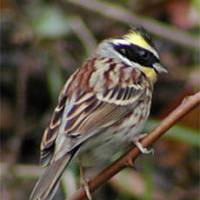* Japanese name: Kimayuhojiro
* Scientific name: Emberiza chrysophrys
* Description: Buntings are related to finches and sparrows, but the Yellow-browed bunting -- whose Japanese name means "yellow eyebrow white cheek" -- is distinguished from them by its rather large head, brown-streaked upperparts and white underside. In the breeding season, the male also has a bright yellow eyebrow stripe on a black head with a white crown. The bird looks like it's wearing a ninja eye mask, which -- given the males' penchant for clandestine behavior (see below) -- is quite appropriate. The bird has a stout pink bill, and its song is a rattling trill
* Where to find them: All over Japan and even, if you are lucky, in parks and gardens in Tokyo. But buntings prefer farmland with trees and hedges to forage through and in which to make their nests where the females lay four eggs.
* Food: Insects and seeds. In winter, buntings tend to eat seeds (from cereal crops and weeds; that's why they have a stout bill) and in the spring and summer, when they are feeding their chicks, they forage for insects. Grasshoppers are a favorite invertebrate and a good source of nutrients for the baby buntings.
* Special features: There is a good reason for the loud song of the male bunting, and for the bright yellow eyebrow. The former functions to proclaim a male's territory, where his female resides; the latter to advertise his sexual prowess. Buntings are caught in a double bind: They want to stray as much as possible into other male's territories, and quickly mate with their females, but they should also closely guard their own territory to prevent their neighbors doing the same thing. The testes of buntings are much larger than would be expected from a bird of this size, suggesting that the temptation to mate with other females ("extra-pair copulation" is how biologists term it) wins out over the guard-duty option. DNA fingerprinting has confirmed that a huge proportion of nests contain a chick not fathered by the male who feeds it. The sperm length, incidentally, is among the longest recorded in any bird.
50 mins ago

















With your current subscription plan you can comment on stories. However, before writing your first comment, please create a display name in the Profile section of your subscriber account page.